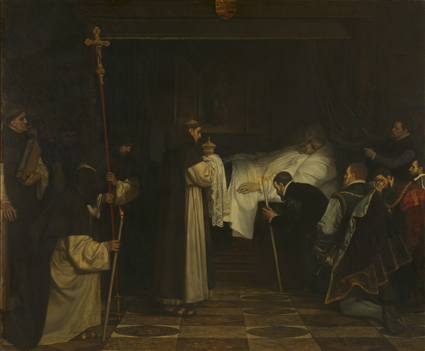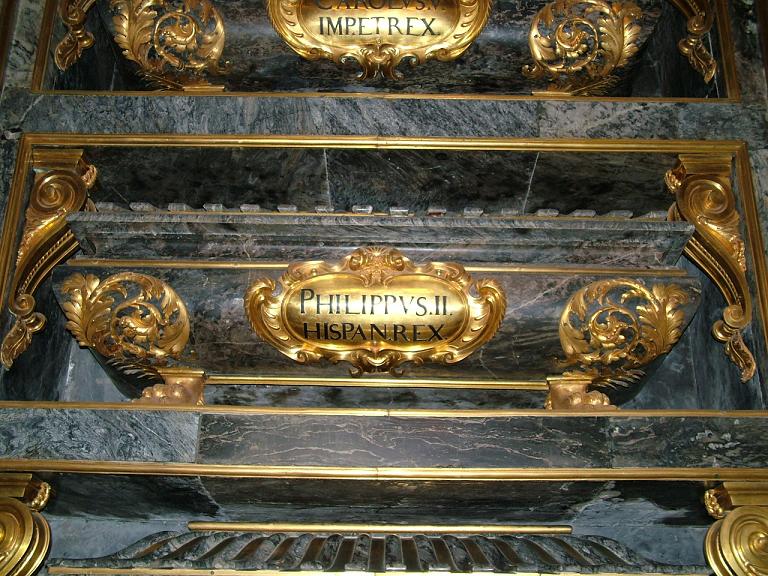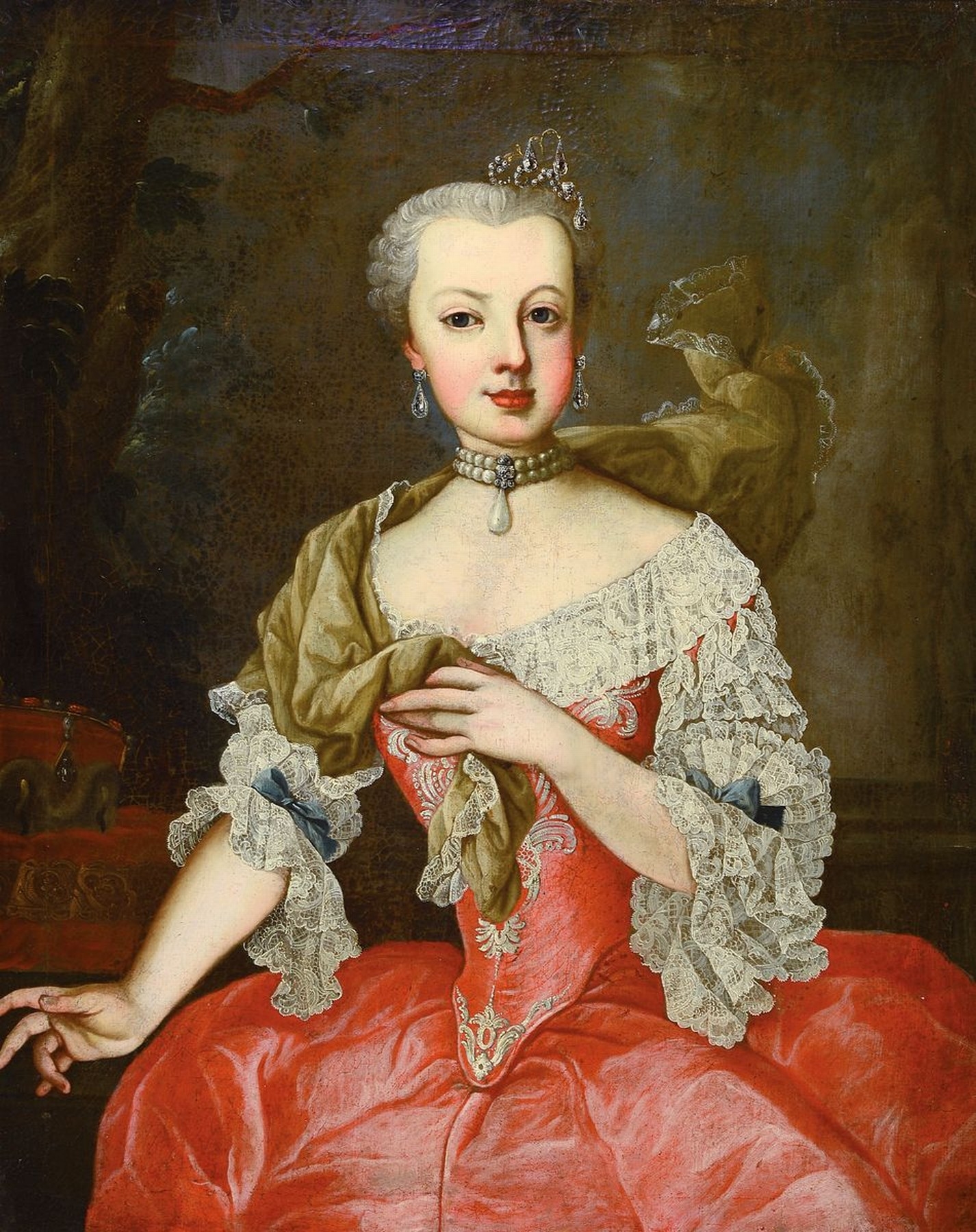25th of October, 1554.
Prinsenhof, Low Countries. 25th of October, 1554.
Felipe approached his aunt as soon as he saw her, bowing his head to a woman of great age and respect. She offered him her hand and he took it, pressing a small kiss to her knuckles as he raised himself to look in her eyes. Catalina of Austria was a tiny and fat woman, with a fleshy neck but kind eyes who looked at him motherly.
“Dearest aunt,” said Felipe, “How is my child? How is my Infanta Luisa?”
His aunt smiled. “Well,” she said. “The damned woman that married my poor son did me the honour of inviting me to the wedding. Luisa looked beautiful and very happy.” Felipe nodded.
“My only hope is that she will enjoy the same love and satisfaction that you and I have enjoyed in our own marriages,” he said. His aunt nodded, clutching a medal in her chest that he imagined held a portrait of her deceased husband. “I hear your grandson Philipp von Wittelsbach has finally married my cousin, Archduchess Barbara.”
“He has,” said the Dowager Duchess of Milan. “I intend to visit them in the Palatine both once my business with your father is done.” She cupped his face. “You look well, my boy. It has been so long since I last saw you.” His aunt married soon after his birth, once the arrival of a male heir secured his father in his Castilian throne. “After my marriage, I thought I’d never see another Habsburg again.”
Felipe smiled, though he said nothing because at that moment, the herald struck his staff against the floor and shouted, “Their Royal Highnesses, Maximilian and Juana of Austria.” He turned and looked at the faces that he had not seen in years. His little sister, miniscule next to her muscled husband, swollen with another pregnancy. His cousin, wearing a large feathered hat and a serious expression on his face.
“What are they doing here?” his aunt asked behind him. “I thought that after the war, surely…”
“Look around, tía,” said Felipe. “All of the estates are represented.” He sighed. “Even Saxony has sent an ambassador. And the Dowager Duchess of Burgundy.” He looked at the man, wearing the Duchess’ colours. She couldn’t bother to come meet with his dying father. Or to allow her son to see his grandfather a final time.
“Surely, you don’t mean to say what I think,” said his aunt. “Charles would never…” He didn’t respond to her. Instead, Felipe walked to greet his sister, who was whispering something in German to her husband. Fernando had already gone to speak with them and his sister embraced their little brother, her eyes closed when he stopped before them.
“Sister,” said Felipe. He looked at Maximilian. “Cousin.”
“Felipe,” Juanita said. “It’s great to see you again.” She didn’t move to embrace him though and Felipe understood that the strains of his father’s actions still hung between them. He sighed, eyes moving down to her large belly and attempted a smile.
“I’m happy to see you, Juana,” he said. “And to see so much of you.”
Juanita smiled, running a hand down her stomach. “Children are a continuous blessing, though I would have liked for Father to have waited for me to give birth before he summoned us here.”
“An emperor doesn’t wait,” said Fernando. “I’m certain that all of our questions will be answered.”
Before Felipe could speak, the herald banged his staff against the floor again, and the sound of trumpets echoed in the room, indicating a royal arrival. Having been standing in the corridor, they entered the great hall, large enough to hold all of the two hundred or so people who were present. Minor lords, members of minor branches of ruling families. He could see even a man with reddish-brown hair sporting the Württemberg coat of arms that could be no one except his cousin, the Duke himself.
His father entered the room from a side entrance, limping heavily on his cane. As he passed, the people bowed deeply for their Emperor and Felipe saw, from the corner of his eye, as his aunt stopped beside him. He was standing before the throne as his father sat down, tired and old, sickly, and he couldn’t stop the racing of his own heart, mind wondering what was happening even though he already knew.
“I’d like to say some things first,” said the Emperor. His trembling hands opened a folded piece of paper and Felipe could see how weak his father was, how tired. “A short time ago, in Castile, my mother died, who, too long ago, gave birth to me between these walls.” He stopped and looked around himself. Charles felt his own heart race as he wondered about the young woman of just twenty who brought him to the world inside a privy. “Her sacrifice allowed me to govern these lands at the age of seventeen. Then, and being still a youngster, I was called upon to rule the Empire of my grandfather, at the same time as I ruled Naples, Sicily and the Spanish kingdoms, as well as the oversea lands.”
The room was entirely silent save for his words, all eyes turned to him. Charles looked at his family. His sister, his son, his daughter and his nephew. The only ones that he trusted to make the journey. Isabel and Catalina belonged to their husbands. Juanita was clutching Maximilian’s arm, her eyes as wide as saucers.
“I sought the imperial crown not in order to rule over a multitude of kingdoms but merely to ensure the welfare and prosperity of the country and my other kingdoms, and to preserve peace and concord in the whole of Christendom.” He hesitated, the weight of so many years giving him fatigue and pain. “To this purpose have I made many arduous journeys and have been compelled to wage many wars, but never wantonly, always very much against my own will. I had great hopes. Only few have been fulfilled and few have remained to me, and at the cost of what travails! This has made me sick and weary. I must for my part confess that I have often misled myself, either from youthful inexperience, from the pride of mature years, or from some other weakness of human nature..” He looked up again. “My life has been one long journey.”
He looked at Felipe. His son. His poor son. He remembered still the day they placed in his arms for the first time, that happy day where he declared that his son would bear the name of his grandfather.
Charles returned his eyes to his papers, continuing to read the speech he prepared. “A journey which has not only consumed this body of mine, but also took me away often from my most beloved companies.” He looked at Felipe. “Of my children.” He looked at Juanita, who had tears running down her cheeks. “Of my wife, to whom I would have liked to give all of my days.”
He looked at Maximilian, the nephew he didn’t know and barely trusted. “I have battled, often obligated, to defend myself from the ambitions of others, and from those whom I thought to be my only enemy, the Turks.” He looked at Catalina, his little sister. The sister he only met when he was seventeen. “And from that punishment-made king that was Francis of France to me.” He thought of Elisabeth, dead from puerperal fever, who would have lived if he hadn’t married her to the French king. The sister who died hating him. “Besides I had to fight against the outbreak of heresy in the very empire I was trusted to protect, and lived to see the Protestants and Catholics brought closer together. But none of these labours have ached as much as what is now to be my final farewell.”
Those present looked at each other, confused and afraid. Charles paused for a moment before he continued, “I no longer have the strength to rule these lands that God has entrusted me with. And the little I have left will soon run out.” He looked down at his paper. “Being so tired now, I cannot do to you any service that those who receive my legacy will do on their own.” He looked up. “To Felipe, my firstborn son, I give the Spanish kingdoms, the Italian lands and the Indies. To my grandson Philippe, as was decided in its day, I bequeath the Low Countries and Burgundy, now converted to the rank of the Kingdom of Burgundy, to rule it as ably as his father would have done.” His heart ached as the image of Juan as he was came to his mind. A happy boy, who was studious and gentle. “And the Empire…” He looked at Juanita and Maximilian. “The Empire will remain in the hands of my brother Ferdinand, whom I wished had come here so I could look in his eyes as I give it to him, were it not for the strains that brotherly relations have over the years.”
Maximilian opened and closed his mouth, knowing that it was not yet the moment to speak.
“I know he will govern it with the same brightness which he has ruled with for the past thirty years, with the happiness of having, in my son, as his most trusted ally,” Charles continued. “Although there are many enemies, the power of that union alone will defeat them, as I know well. I nonetheless declare to you that I never knowingly or willingly acted unjustly. If actions of this kind are nevertheless justly laid to my account, I formally assure you now that I did them unknowingly and against my own intention. I therefore beg those present today, whom I have offended in this respect, together with those who are absent, to forgive me.” He looked up again. “Soon I will leave for Spain and never come back. Stay faithful to God, children, for in my heart, you will all remain safe and sane.”
Juanita burst into tears, clutching her husband’s hand. Fernando placed a hand over his sister’s shoulders, his own cheeks wet with sadness. Charles stood up and the people bowed to him one final time. The man that walked out of the room was limping on a cane, dressed in simple black clothes with white hair and a face covered in wrinkles. He did not look like an emperor, because he wasn’t one.
Not anymore.








